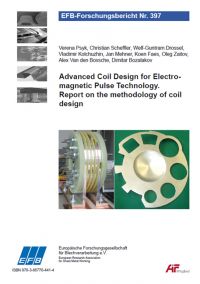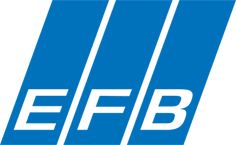Advanced Coil Design for Electromagnetic Pulse Technology. Report on the methodology of coil design

(Entwicklung einer Methode zur systematischen Auslegung für Spulen für die Elektromagnetische Pulstechnologie)
Verfasser:
Dr.-Ing. Verena Psyk, Dipl.-Ing. Chriatian Scheffler, Prof. Dr.-Ing. Welf-Guntram Drossel, Fraunhofer Institute for Machine Tools and Forming Technology - Dr.-Ing. Vladimir Kolchuzhin, Prof. Dr.-Ing. habil. Jan Mehner, Chemnitz University of Technology, Chair of Microsystems and Precision Engineering - Dr. ir. Koen Faes, Oleg Zaitov, Belgian Welding Institute - Prof. Dr. ir. Alex Van den Bossche, Dimitar Bozalakov, University of Gent – Department Electrical Energy, Systems and Automation
356 Seiten - 128,00 EUR (sw, 282 teils farbige Abb., 64 Tab.)
ISBN 978-3-86776-441-4
Summary
Electromagnetic forming (EMF) is a relative new and attractive technology, which can be used for joining, welding, forming and cutting of metals. The technology is based on the utilisation of electromagnetic forces and offers attractive possibilities for:
- obtaining a larger deformation of some materials, in comparison with conventional forming, while avoiding the disadvantages of the conventional processes,
- fast and cost-effective joining of non-weldable materials, like heterogeneous joints;
- creating complex or new workpieces and products, impossible by conventional technologies,
- improving the working conditions of the welders or operator, since EMF is environmentally clean (no heat, fumes, shielding gases, radiation, etc.).
The critical part of the technology is the coil, which is always application-specific designed. When inappropriately designed or constructed, these parts fail very quickly, or low process efficiency is obtained. Durable, robust and efficient coil systems are however essential for a successful implementation of EMF in industry.
Currently, the knowledge concerning coil design is dispersed among the pulse machine manufactures, often confidential and thus not available for end users. One of the aims of the project is to develop all necessary knowledge to provide SMEs and other companies the flexibility to design and manufacture coils for specific applications. This will lead to an increased use and applicability of EMF in the metal processing industry.
The technical targets aimed at in this project are:
- Development of finite-element models, which will increase the knowledge about the process and which will serve as a tool in the coil design process.
- Methodology for designing coils for forming and cutting of sheets and forming and welding of tubular workpieces.
- Guidelines for manufacturing, material selection, insulation strategy and other construction-related aspects.
- Manufacturing and testing of coil prototypes, for the development of industrial applications.
- Providing the companies with all essential information to make a considered decision about the successful integration of the EMF and related technologies in their production.
The final goal of the project was to enable companies to produce in a faster and a more efficient way by implementing EMF, which is currently hindered by the difficulties in designing the right coil. Due to an increased productivity and cost reduction by using this advanced technique, joining and forming operations will be performed faster and more efficient, so more economic, due to a less expensive production process and a better guarantee of the quality.
The experimental research using pulsed-power equipment was performed by Fraunhofer IWU and the Belgian Welding Institute. EELAB of the Ghent University used its expertise in the field of calculation of magnetic forces, current density, etc. in order to calculate the desired shape of the coil systems. Finite-element modelling of the process was performed by the University of Chemnitz.
The project "Advanced Coil Design for Electromagnetic Pulse Technology." Ref.-No. AiF 61EBR was financed and supervised by the EFB. In the scope of the CORNET - European Research Programme “ACODEPT” it was funded by the German Federal Ministry for Economic Affairs and Energy via the Federation of Industrial Research Associations. The report is published as EFB-Forschungsbericht Nr. 397.
Zusammenfassung
Die elektromagnetische Umformung (EMU) ist eine innovative Technologie für die Formgebung sowie für das Fügen und Trennen durch Umformung. Sie basiert auf der Nutzung elektromagnetischer Kräfte und bietet aussichtsreiche Möglichkeiten für:
- Das Erreichen höherer Umformgrade im Vergleich zu konventionellen Umformverfahren für zahlreiche Werkstoffe,
- Schnelles wirtschaftliches Fügen auch konventionell nicht schweißbarer Werkstoffkombinationen,
- Die Umsetzung komplexer Bauteile, die konventionell nicht realisierbar wären
- Verbesserung der Arbeitsbedingungen für Schweißer und Anlagenführer, da die EMU die Umwelt nicht belastet (keine Hitze, Rauch, Schutzgase, Abstrahlung)
Entscheidend in Bezug auf den erfolgreichen Einsatz des Verfahrens ist die Werkzeugspule bzw. der Induktor, der unter Berücksichtigung anwendungsspezifischer Aspekte und angepasst an den jeweiligen Stoßstromgenerator auszulegen ist. Eine unzweckmäßig konstruierte Spule hat ein frühzeitiges Versagen von Komponenten und/oder einen geringen Prozesswirkungsgrad zur Folge. Es ist daher erforderlich, beständige, stabile und effiziente Spulensysteme einzusetzen, um einen erfolgreichen Einsatz der EMPT in der Industrie zu gewährleisten.
Kenntnisse bezüglich des Induktordesigns sind als Know-How der Herstellerfirmen von EMU-Equipment meist geheim und nicht verfügbar für Endverbraucher. Wesentlicher Projektinhalt war daher die Sammlung und Erweiterung sowie die Aufbereitung und Bereitstellung des Wissens für KMUs und andere Unternehmen. Diesen soll so die Möglichkeit gegeben werden, Spulen für spezifische Anwendungen zu entwerfen und zu fertigen, sodass die erwiesenermaßen bestehenden Verfahrensvorteile der EMU in der industriellen Fertigung nutzbar werden.
Somit tragen die Ergebnisse des Projektes direkt dazu bei, Unternehmen durch die Implementierung der EMU dabei zu unterstützen, schneller und effizienter zu produzieren.
Um diese übergeordnete Zielsetzung zu erreichen wurde im Rahmen des Projektes
- eine Finite-Elemente-Modelle entwickelt, die das Wissen über den Prozess erweitern und als Werkzeug im Spulenentwicklungsprozess dienen,
- eine Methodik für den Entwurf von Induktoren erarbeitet
- Informationen bezüglich der Werkstoffauswahl und Fertigung von Induktoren zusammengestellt
- Prototypische Induktoren entwickelt, umgesetzt und erprobt, um die genannten Ansätze zu verifizieren
Die experimentellen Untersuchungen wurden im Bereich des Umformens und Trennens von Blechen im Wesentlichen vom Fraunhofer-Institut für Werkzeugmaschinen und Umformtechnik (IWU) und im Bereich des Fügens von Rohren und Hohlprofilen vornehmlich durch das Belgium Welding Institute (BWI) durchgeführt. Das Electrical Energy Laboratory der Universität Gent (EELAB) unterstütze das Projekt mit seiner Fachkompetenz hinsichtlich der Berechnung beispielsweise von magnetischen Kräften, der elektrischer Stromdichte, etc. Die Finite-Element-Modellierung war Schwerpunkt der Arbeiten der Professur für Mikrosystem- und Gerätetechnik der Technischen Universität Chemnitz (TUC).
Das Vorhaben „Advanced Coil Design for Electromagnetic Pulse Technology“ wurde unter der Fördernummer AiF 61BR von der Forschungsvereinigung EFB e.V. finanziert und betreut und über die Arbeitsgemeinschaft industrieller Forschungsvereinigungen (AiF) im Rahmen des CORNET-Programms vom Bundesministerium für Wirtschaft und Energie aufgrund eines Beschlusses des Deutschen Bundestages gefördert. Der Abschlussbericht ist als EFB-Forschungsbericht Nr. 397 erschienen und bei der EFB-Geschäftsstelle und im Buchhandel erhältlich.
Content
1. Projektzusammenfassung
2. Project summary
3. Administrative data of the project
3.1. Title of the project
3.2. Coordinator and partners
3.2.1. Research partner: Fraunhofer Institute of Machine Tools and Forming Technology (IWU)
3.2.2. Research partner: Chemnitz University of Technology (TUC), Department of Electrical Engineering and Information Technology, Chair of Microsystems and Precision Engineering
3.2.3. Research partner: University of Gent - Department Electrical Energy, Systems and Automation - Research group EELAB (EELAB)
3.2.4. Research partner: Belgian Welding Institute (BWI)
4. Brief introduction to electromagnetic forming
4.1. Working principle
4.2. Advantages of the process
4.3. Coils
5. Objectives of the ACODEPT project
6. Research method
7. European cooperation
8. Introduction to the work program
9. State-of-the art of the electromagnetic pulse technology, analysis of coil systems and definition of the methodology (WP1)
9.1. State-of-the art of the electromagnetic high-velocity processes
9.1.1. Process principle and variants
9.1.2. Process applications
9.1.3. Historical development of electromagnetic forming
9.2. Analysis of existing coil systems and their applications
9.2.1. Cylindrical coils
9.2.2. Flat coils
9.3. State-of-art of coil design
9.3.1. Load oriented coil design
9.3.2. Efficiency-oriented coil and process design
9.3.3. Application oriented coil design
9.4. Identification of relevant coil parameters and their influence on the process performance and coil life time (Task 1.3)
9.4.1. Influence of the parameters on the pulse character
9.4.2. Coil failure
9.4.3. Coil lifetime
9.5. Selection of applications
10. Conceptual design of application oriented flat and cylindrical coils (WP2)
10.1. Introduction and general approach for coil design within the ACODEPT project
10.2. Preliminary tool design
10.2.1. Definition of application dependent requirements
10.2.2. Deduction of a suitable pressure pulse
10.2.3. Draft geometry of the tool coil and field shaper if applicable
10.2.4. Determination of the magnetic field and calculation of the according forces and magnetic pressure
10.2.5. Evaluation of the magnetic field and pressure
10.3. Improved design of cylindrical Bitter compression coils using analytical calculations
10.3.1. Limitations of the analytical approach
10.3.2. Design methodology
10.3.3. Field shaper geometry value assignment and parameters estimation
10.3.4. Auxiliary calculations
10.3.5. Design limitations
10.3.6. Calculation of the inductance and the active resistance of the coil
10.3.7. Calculation of the central magnetic field using the Fabry formula
10.3.8. Coil optimisation based on analytical calculations
10.4. Modelling of the magnetic field produced by a coil system using FEMM
10.4.1. Methodology of modelling in FEMM
10.4.2. Coil input data
10.4.3. Magnetic field in the working volume
10.4.4. Current density distribution in a turn
10.4.5. Inductance and resistance of the coil
10.4.6. Conclusions of the FEMM simulation of the coil
10.4.7. Field shaper input data
10.4.8. Efficiency estimation
10.4.9. Conclusions of the FEMM simulation of the coil system
10.5. Parametric study of a Bitter coil by 3D FEM analysis
10.6. Experimental verification of the methodology
10.6.1. Resistance and inductance calculation based on current curves obtained during no-load experiments
10.6.2. B-field measurements with the use of a measuring coil
10.6.3. RLC bridge measurements
10.6.4. Measurement of the active resistance of the coil to constant current
10.6.5. Analysis of the experimental results
10.6.6. Conclusion
10.7. Design of Bitter coils for flat forming and cutting
10.8. Design of flat coils
10.9. Improved design using analytical calculations of cylindrical helix coils
10.9.1. Initial simulations
10.9.2. Initial calculations
10.9.3. Initial data for the design
10.9.4. Design steps
11. Optimised tool design using finite-element simulations (WP3)
11.1. Modelling approaches, software, hardware
11.2. 2D FE-simulation
11.2.1. Model setup, boundary and terminal conditions in 2D ANSYS
11.2.2. Simulation of cylindrical coil system with field shaper in 2D
11.3. Numerical determination of the magnetic field (3D)
11.3.1. 3D FE-simulation and comparison study of Uniform pressure coils
11.3.2. 3D FE-simulation: Field-shaper for cutting process
11.4. Coupled simulation with LS-DYNA
11.4.1. Model setup and boundary conditions in LS-DYNA
11.4.2. Essential LS-DYNA keywords used for electromagnetic forming.
11.4.3. Common errors in EM calculations with LS-DYNA
11.5. Results of the cutting simulation and experimental comparison
12. Material definition for coil systems (WP 4)
12.1. Conductor materials
12.2. Housing materials
13. Investigation of manufacturing techniques for coils (WP5)
13.1. Introduction
13.2. Coil with a constant current density.
13.3. Coil with a current density proportional to 1/r or Bitter coil.
13.4. Helix solenoid
13.5. One turn coil and field shaper
13.6. Technological methods for improving the resource of coils
14. Manufacturing of coil prototypes (WP6)
14.1. Manufacturing of a flat coil prototype
14.2. Manufacturing of a cylindrical Bitter coil prototype
14.2.1. Description
14.2.2. Specifications
14.2.3. Assembly process
14.3. Manufacturing of a cylindrical helix coil prototype
14.3.1. Preparation steps
14.3.2. Winding step
15. Testing of coils (WP7)
15.1. Testing of cylindrical coils for flat forming and cutting
15.2. Testing of flat coils
15.3. Testing of cylindrical coils
16. Manufacturing of demonstration workpieces (WP8)
16.1. Demonstration work pieces for cutting and flat forming
16.2. Demonstration work pieces for joining of tubular products
17. Dissemination of results and project management (WP9)
17.1. Benefit and economic importance of the research results for the SMEs
17.2. Task 9.1: Project Management and dissemination of results
18. APPENDIX
18.1. APPENDIX 1:List of Symbols
18.2. APPENDIX 2:List of Abbreviations
18.3. APPENDIX 3: List of Figures
18.4. APPENDIX 4: List of Tables

